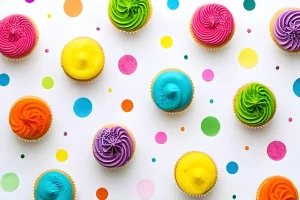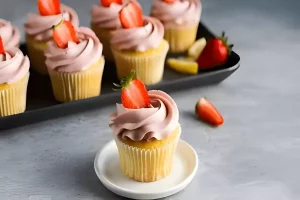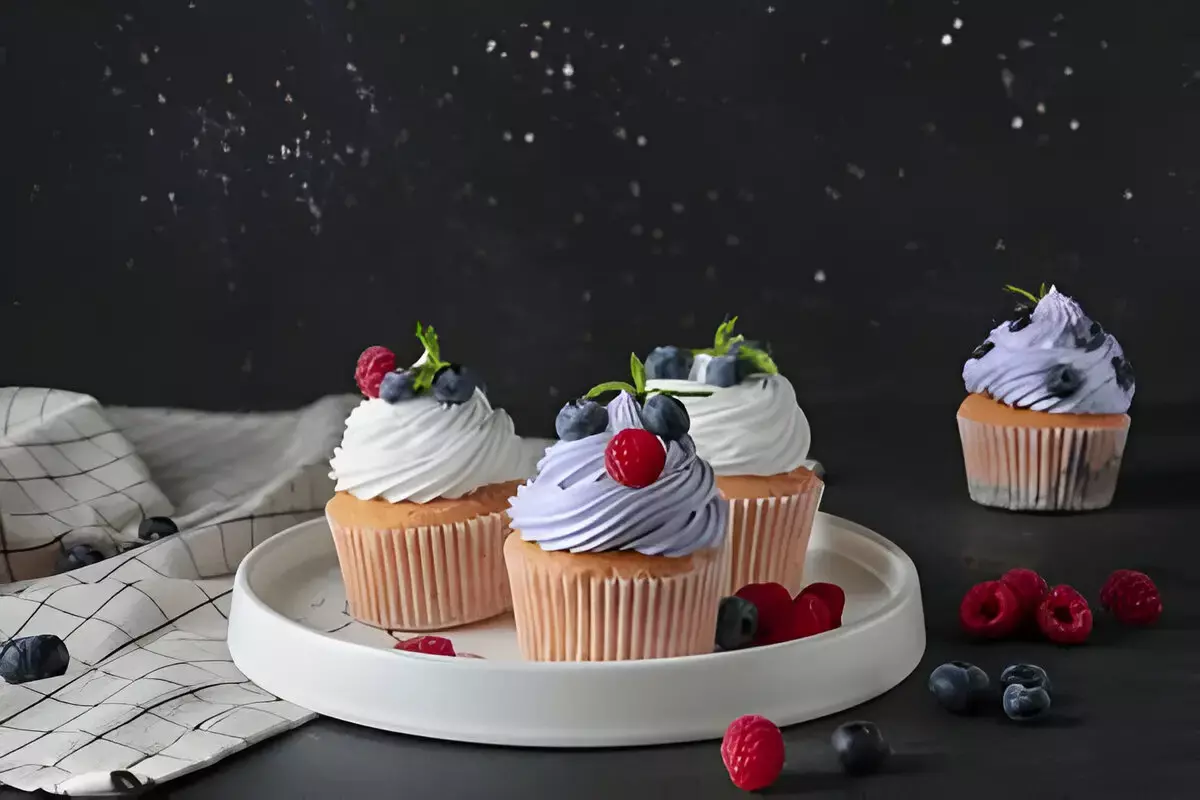Embarking on the journey of gluten-free baking can often feel like venturing into uncharted territories. With a rising awareness of gluten sensitivities and celiac disease, the demand for gluten-free options in baking has skyrocketed. Among these, gluten free cupcakes stand out as a delightful treat that everyone, regardless of dietary restrictions, can enjoy. These cupcakes promise all the joy and flavor of traditional baking, without the gluten. In this comprehensive guide, we’ll explore the art of making these delectable treats, ensuring that every bite is as satisfying as it is safe.
Part 1: Introduction to Gluten-Free Cupcakes
Gluten-free baking isn’t just a trend; it’s a gateway to culinary inclusivity, allowing everyone to indulge in the joy of baked goods. The evolution of gluten free cupcakes from niche dietary need to mainstream delight reflects a broader acceptance and understanding of dietary restrictions. These cupcakes, with their light, fluffy texture and rich flavors, have become a staple in bakeries and households alike.
The key to mastering gluten-free cupcakes lies in understanding the alternatives to traditional wheat flour. Ingredients like almond flour and coconut flour not only provide the necessary structure and texture but also add their unique flavors to the mix. Moreover, the use of binders like xanthan gum ensures that these cupcakes maintain the desired consistency, mimicking the glutenous network found in regular baked goods.
But the journey doesn’t stop at merely substituting ingredients. The true art of gluten-free baking lies in experimentation and adaptation, ensuring that each cupcake is a testament to both taste and texture. Whether you’re a seasoned baker or just starting, this guide will navigate you through the nuances of gluten-free baking, making every batch of cupcakes a celebration of flavor and inclusivity.
For those embarking on this baking journey, consider exploring our guide to “Baking Time for Mini Cupcakes: Your Complete Guide”, which offers insights into perfecting cupcake sizes and baking times, a useful complement to gluten-free baking endeavors.
Why Choose Gluten-Free Cupcakes?
Beyond Dietary Needs: Unlocking Flavorful Experiences
Opting for gluten free cupcakes isn’t just a matter of dietary necessity; it’s a choice that opens up a world of delightful possibilities. Beyond catering to those with gluten sensitivities or celiac disease, these cupcakes offer a unique taste experience that even the most conventional palates can appreciate. The variety of gluten-free flours available today brings a spectrum of flavors and textures previously unexplored in traditional baking.
Health Benefits and Inclusivity in Gluten-Free Baking
One of the most compelling reasons to go gluten-free is the health benefits it provides for those with gluten-related disorders. For individuals with celiac disease, consuming gluten triggers an immune response that can damage the small intestine, leading to serious health complications. Gluten sensitivities, while not as severe, can still cause discomfort and health issues for many. Gluten-free cupcakes offer a safe and enjoyable option for these individuals, ensuring they don’t miss out on life’s sweet moments.
Creativity and Taste Exploration in Every Bite
But the appeal of gluten-free cupcakes extends far beyond dietary restrictions. Many people find that gluten-free baking offers a lighter, more digestible alternative to traditional baked goods, making them a preferable choice for anyone looking to reduce their gluten intake for general health reasons. Additionally, the creativity involved in gluten-free baking, with its diverse range of flours and ingredients, often results in cupcakes that are not only safe for those with allergies but also irresistibly delicious.

Embracing Inclusivity Through Culinary Delights
Embracing gluten-free cupcakes is about more than just avoiding gluten; it’s about discovering new tastes, experimenting with ingredients, and ultimately, creating inclusive culinary delights that everyone can enjoy. Whether you’re baking for a friend with dietary restrictions or simply exploring the vast world of gluten-free flavors, these cupcakes promise a delightful and inclusive experience for all.
Further Resources for Gluten-Free Living
As we delve deeper into the world of gluten-free baking, don’t forget to check out our comprehensive guide on “Gluten-Free Living: Your Comprehensive Guide”, which offers valuable insights and tips for embracing a gluten-free lifestyle beyond just cupcakes.
Key Ingredients for Gluten-Free Cupcakes
Diving into the world of gluten free cupcakes requires a pantry stocked with the right ingredients. The cornerstone of gluten-free baking lies in the flours used. Unlike traditional baking, which predominantly relies on wheat flour, gluten-free recipes often call for a blend of alternative flours to mimic the texture and structure that gluten provides.
Understanding Gluten-Free Flours
- Almond Flour: Rich in flavor and moist in texture, almond flour adds a nutty depth to cupcakes, making them deliciously dense yet surprisingly light.
- Coconut Flour: Highly absorbent and slightly sweet, coconut flour is a staple for adding volume and a delicate flavor to gluten-free cupcakes.
- Rice Flour: A neutral-tasting option that provides a smooth texture, making it an excellent base for various cupcake flavors.
These flours, each with their unique properties, require careful consideration and balancing to achieve the perfect cupcake consistency. For instance, while almond flour adds moisture, too much can lead to overly dense cupcakes. Conversely, coconut flour’s absorbency means you’ll need to adjust liquid ingredients to avoid dryness.
Additional Ingredients
- Xanthan Gum: This is the glue that holds gluten-free baked goods together. Just a pinch can prevent your cupcakes from crumbling.
- Eggs: A crucial ingredient, eggs add structure and lift, compensating for the lack of gluten’s binding properties.
- Milk Alternatives: Dairy-free milks like almond or coconut milk not only cater to those avoiding dairy but also complement the flavors of gluten-free flours.
Mastering gluten-free cupcakes is all about understanding the interplay of these ingredients. It’s not just about replacing wheat flour with a gluten-free counterpart; it’s about crafting a harmonious blend that celebrates the unique characteristics of each component. Experimentation is key – the ratios can vary based on the desired texture and flavor, making each batch of cupcakes a new adventure.
For those eager to explore the vast world of gluten-free flours further, our guide on “Gluten-Free Chicken Noodle Soup Recipe & Tips” offers insights into using these flours beyond desserts, demonstrating their versatility in savory dishes as well.
Step-by-Step Baking Guide
Mastering gluten free cupcakes is an art and a science, blending the right ingredients with precise techniques to create the perfect batch. Here’s a foolproof guide to ensure your gluten-free cupcakes are as delightful in texture as they are in taste.
Preparation Steps
Mix Dry Ingredients:
Begin by whisking together your chosen blend of gluten-free flours, a pinch of xanthan gum (if your flour blend doesn’t include it), baking powder, and a little salt. This ensures an even distribution of the leavening agents for a consistent rise.
Cream Butter and Sugar:
In a separate bowl, beat together softened butter and sugar until light and fluffy. This process, known as creaming, incorporates air into the mixture, contributing to the lightness of the cupcakes.
Add Eggs:
One at a time, beat in eggs, ensuring each is fully incorporated before adding the next. Eggs provide structure and moisture, key for gluten-free baking.
Combine Wet and Dry Mixtures:
Alternately add the dry ingredients and your choice of milk alternative to the butter mixture, starting and ending with the dry. This method prevents the batter from curdling and helps achieve a smooth, homogenous mix.
Flavor It Up:
Stir in vanilla extract or any other flavorings you fancy. Gluten-free baking is a canvas for creativity – don’t shy away from experimenting with different extracts, zests, or spices.
Fill and Bake:
Spoon the batter into cupcake liners, filling each about two-thirds full. Bake in a preheated oven at 350°F (175°C) until a toothpick inserted into the center comes out clean, usually around 18-22 minutes. Keep an eye on them; gluten-free cupcakes can go from perfect to overdone in a blink.
Cooling:
Let the cupcakes cool in the pan for a few minutes before transferring them to a wire rack. Patience is a virtue here; cooling ensures the cupcakes set properly and don’t fall apart.
These steps are your roadmap to gluten-free cupcake bliss. Remember, the key to perfect gluten-free baking lies in the details – the right ingredients, the right techniques, and a bit of patience. Each batch is a learning experience, bringing you one step closer to gluten-free perfection.
For those interested in further honing their baking skills, exploring our guide on “Make Mini Cupcakes: Your Guide to Bite-Sized Delights” offers additional tips and techniques for perfecting cupcakes of all sizes, ensuring your gluten-free baking adventures are always a resounding success.
Flavor Variations and Creative Ideas
The realm of gluten free cupcakes is a playground for the creative baker. Once you’ve mastered the basic recipe, the door opens to a world of flavor possibilities. Whether you’re a fan of classic tastes or looking for something to spark your culinary creativity, gluten-free cupcakes offer a canvas for your imagination.
Classic and Creative Flavors
- Vanilla and Chocolate: Start with these timeless flavors. Vanilla offers a warm, comforting aroma, while chocolate brings a rich, indulgent depth. Don’t hesitate to explore different types of cocoa or vanilla beans to find the taste that speaks to you.
- Red Velvet with a Twist: Red velvet cupcakes are known for their vibrant color and subtle cocoa flavor. In a gluten-free version, try beetroot powder for natural coloring and an added health boost, giving these cupcakes an extra layer of intrigue.
- Seasonal Specials: Embrace the seasons by incorporating fresh, seasonal fruits or spices. Think pumpkin spice in autumn, fresh berries in summer, or cinnamon and ginger during the holidays. Seasonal ingredients not only add unique flavors but also make your baking feel more connected to the world around you.

Decorating Gluten-Free Cupcakes
- Frostings and Icings: From classic buttercream to dairy-free alternatives like coconut cream frosting, the options are endless. Flavor your frostings with pureed fruits, zests, or natural food colorings for a vibrant finish.
- Creative Toppings: Unleash your creativity with toppings. Fresh fruits, edible flowers, gluten-free cookie crumbles, or homemade jam dollops can transform your cupcakes into edible art pieces.
- Themed Decorations: Tailor your cupcakes to occasions. Use themed decorations for birthdays, holidays, or special events, turning your gluten-free creations into the centerpiece of any celebration.
Experimentation is the heart of great baking. Each batch of cupcakes is an opportunity to try something new, to blend flavors and textures in ways that delight and surprise. Whether sticking to the classics or venturing into uncharted culinary territories, the key is to bake with passion and creativity.
For those eager to dive deeper into the art of cupcake decoration, our article “Bake Mini Cupcakes: Your Complete Guide to Perfectly Delightful” offers a treasure trove of tips and ideas to elevate your gluten-free cupcake game, ensuring that every batch you bake is not only delicious but also a feast for the eyes.
Common Challenges and Solutions
Navigating the waters of gluten free cupcakes can sometimes feel like sailing through a storm. But fear not! With every challenge comes a solution, and understanding these common hurdles can help ensure your gluten-free baking adventures are smooth sailing.
Troubleshooting Common Issues
- Crumbly Cupcakes: If your cupcakes are falling apart, it might be due to a lack of binder. Xanthan gum or guar gum can be a lifesaver here, acting as the gluten stand-in to hold your cupcakes together. A tiny bit goes a long way, so start with just a quarter of a teaspoon per cup of flour and adjust as needed.
- Dense Cupcakes: Gluten-free flours can sometimes lead to a denser texture. To combat this, ensure you’re incorporating enough air into your batter during the mixing process. Creaming your butter and sugar thoroughly and sifting your dry ingredients can introduce more air, resulting in lighter cupcakes.
- Dry Cupcakes: Gluten-free flours are often more absorbent than their wheat-based counterparts, which can lead to dryness. To avoid this, consider adding a bit more moisture to your batter. Applesauce, yogurt, or an extra splash of milk alternative can provide the necessary moisture to keep your cupcakes delightfully tender.
- Gummy Texture: Over-mixing your batter can lead to gummy cupcakes. Once you’ve added your dry ingredients to the wet, mix just until combined. Overworking the batter can activate any remaining gluten-like properties in your flours, leading to an unpleasant texture.
Remember, gluten-free baking is as much about intuition as it is about precision. Each batch of cupcakes offers a new learning opportunity, allowing you to fine-tune your technique and ingredients. Embrace the process, and don’t be discouraged by a few missteps along the way.
FAQs
In the journey of mastering gluten free cupcakes, numerous questions might pop up along the way. Here’s a compilation of frequently asked questions that can shed light on common queries and enhance your gluten-free baking experience.
Frequently Asked Questions
Can I substitute one gluten-free flour for another directly?
Each gluten-free flour has its unique properties, affecting texture, flavor, and moisture. Direct substitutions may not always yield the desired results. It’s best to use a blend or follow recipes until you’re familiar with each flour’s characteristics.
How long do gluten-free cupcakes last?
Gluten-free baked goods tend to dry out faster. Store your cupcakes in an airtight container at room temperature for up to two days or refrigerate for up to a week. For longer storage, freeze them without frosting.
Can I make my gluten-free cupcakes vegan?
Absolutely! Substitute eggs with flax eggs (1 tablespoon ground flaxseed mixed with 3 tablespoons water per egg) and use dairy-free milk and butter alternatives. Remember to check that your other ingredients, like baking powder, are also vegan.
Why did my cupcakes sink in the middle?
This could be due to underbaking, opening the oven door too early, or using expired leavening agents. Ensure your cupcakes are fully baked, and always use fresh baking powder or soda.
In your quest for the perfect gluten-free cupcake recipe, don’t forget to explore our article “Mini Cupcakes: Exploring Their Enchanting History” for a dive into the origins and evolution of cupcakes. This historical perspective can add depth to your baking journey, connecting you to the rich traditions and innovations that shape our culinary landscape today.

Conclusion and Encouragement
Embarking on the gluten free cupcakes journey is more than just baking without gluten—it’s about embracing diversity in our diets and inclusivity at our dining tables. It’s a testament to the fact that dietary restrictions don’t have to limit the joy of baking and sharing delicious treats.
As we wrap up this comprehensive guide, remember that each batch of cupcakes is a step forward in your gluten-free baking adventure. The challenges you face and overcome add to your repertoire of skills, making you a more versatile and intuitive baker. Celebrate the successes, learn from the mishaps, and always keep experimenting.
Whether you’re baking for someone with dietary restrictions or simply exploring the vast, flavorful world of gluten-free baking, your efforts bring joy and sweetness to every bite. So, preheat your ovens, gather your ingredients, and let the aroma of freshly baked cupcakes fill your kitchen once again.
For further reading and resources on gluten-free living and baking, consider visiting these reputable sites:
- Celiac Disease Foundation: Celiac
- American Diabetes Association: Diabetes
- Food Allergy Research & Education (FARE): Foodallergy
And for more baking tips, tricks, and recipes, explore our other articles, like “Mini Cupcakes: Exploring Their Enchanting History”, to deepen your understanding and love for the art of baking. Keep baking, keep sharing, and most importantly, keep enjoying the delicious journey of gluten-free cupcakes!

